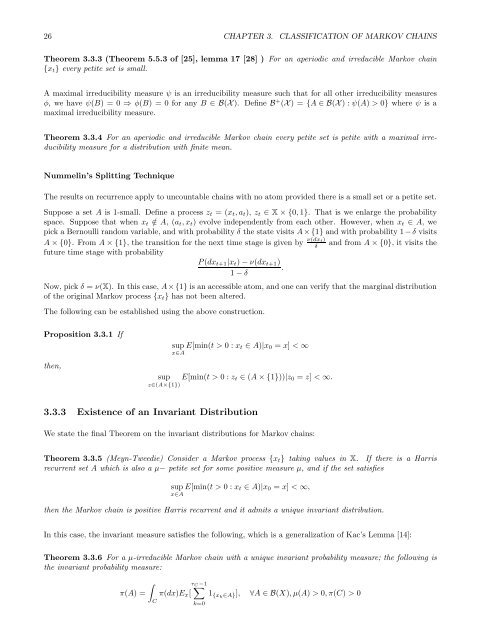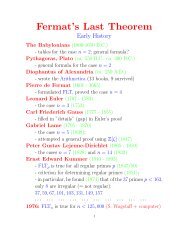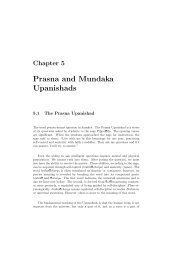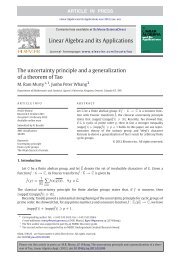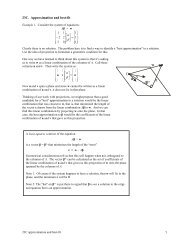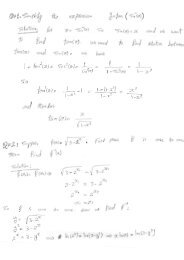Lecture Notes - Department of Mathematics and Statistics - Queen's ...
Lecture Notes - Department of Mathematics and Statistics - Queen's ...
Lecture Notes - Department of Mathematics and Statistics - Queen's ...
Create successful ePaper yourself
Turn your PDF publications into a flip-book with our unique Google optimized e-Paper software.
26 CHAPTER 3. CLASSIFICATION OF MARKOV CHAINS<br />
Theorem 3.3.3 (Theorem 5.5.3 <strong>of</strong> [25], lemma 17 [28] ) For an aperiodic <strong>and</strong> irreducible Markov chain<br />
{x t } every petite set is small.<br />
A maximal irreducibility measure ψ is an irreducibility measure such that for all other irreducibility measures<br />
φ, we have ψ(B) = 0 ⇒ φ(B) = 0 for any B ∈ B(X). Define B + (X) = {A ∈ B(X) : ψ(A) > 0} where ψ is a<br />
maximal irreducibility measure.<br />
Theorem 3.3.4 For an aperiodic <strong>and</strong> irreducible Markov chain every petite set is petite with a maximal irreducibility<br />
measure for a distribution with finite mean.<br />
Nummelin’s Splitting Technique<br />
The results on recurrence apply to uncountable chains with no atom provided there is a small set or a petite set.<br />
Suppose a set A is 1-small. Define a process z t = (x t , a t ), z t ∈ X × {0, 1}. That is we enlarge the probability<br />
space. Suppose that when x t /∈ A, (a t , x t ) evolve independently from each other. However, when x t ∈ A, we<br />
pick a Bernoulli r<strong>and</strong>om variable, <strong>and</strong> with probability δ the state visits A × {1} <strong>and</strong> with probability 1 −δ visits<br />
A × {0}. From A × {1}, the transition for the next time stage is given by ν(dxt) <strong>and</strong> from A × {0}, it visits the<br />
future time stage with probability<br />
P(dx t+1 |x t ) − ν(dx t+1 )<br />
.<br />
1 − δ<br />
Now, pick δ = ν(X). In this case, A×{1} is an accessible atom, <strong>and</strong> one can verify that the marginal distribution<br />
<strong>of</strong> the original Markov process {x t } has not been altered.<br />
The following can be established using the above construction.<br />
δ<br />
Proposition 3.3.1 If<br />
then,<br />
sup E[min(t > 0 : x t ∈ A)|x 0 = x] < ∞<br />
x∈A<br />
sup E[min(t > 0 : z t ∈ (A × {1}))|z 0 = z] < ∞.<br />
z∈(A×{1})<br />
3.3.3 Existence <strong>of</strong> an Invariant Distribution<br />
We state the final Theorem on the invariant distributions for Markov chains:<br />
Theorem 3.3.5 (Meyn-Tweedie) Consider a Markov process {x t } taking values in X. If there is a Harris<br />
recurrent set A which is also a µ− petite set for some positive measure µ, <strong>and</strong> if the set satisfies<br />
sup E[min(t > 0 : x t ∈ A)|x 0 = x] < ∞,<br />
x∈A<br />
then the Markov chain is positive Harris recurrent <strong>and</strong> it admits a unique invariant distribution.<br />
In this case, the invariant measure satisfies the following, which is a generalization <strong>of</strong> Kac’s Lemma [14]:<br />
Theorem 3.3.6 For a µ-irreducible Markov chain with a unique invariant probability measure; the following is<br />
the invariant probability measure:<br />
∫<br />
π(A) =<br />
C<br />
τ∑<br />
C−1<br />
π(dx)E x [ 1 {xk ∈A}], ∀A ∈ B(X), µ(A) > 0, π(C) > 0<br />
k=0


